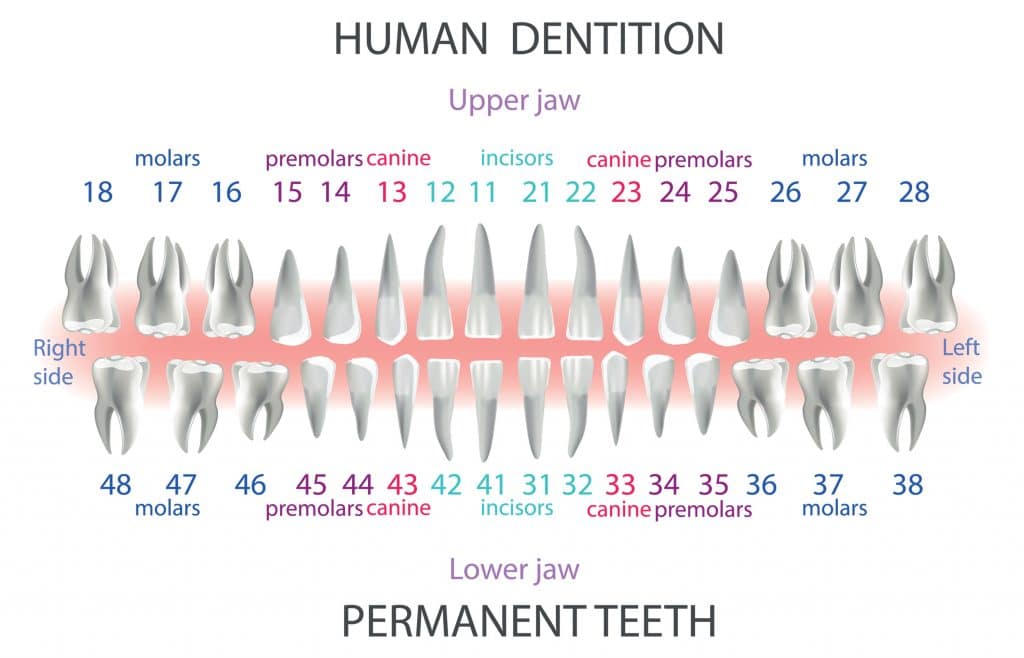

For most parents, by the age of 7, the child will start to lose their baby teeth. Teaching them helps develop lifelong oral health habits that will apply to adult teeth. Healthy development is vital to the appropriate development of the child’s nutrition and speech. The first visit will get your child familiar with the dentist. It is essential to see a dentist if your child does not start to get teeth within the year. A dentist can better explain teeth names and numbers so you can identify them. The collection of teeth that replaces primary teeth are called succedaneous or permanent dentition.Ĭurrent recommendations are to see a dentist as soon as the child turns a year old. There are two sets of teeth in human beings the first are named primary or baby teeth and permanent or adult teeth. On the other hand, children have 20 primary teeth and start to grow their first actual teeth by the age of 6.
Image of teeth numbers professional#
Next time you're at the dentist try to communicate with your dental professional the name or number of your tooth that is being discussed.An adult has 32 teeth, teeth names and number are given based on their arch, class, type, and side. Molars are like a grinding table, carrying out the smashing and grinding of food for digestion. Depending on if you have your wisdom teeth or not you will have 8 or 12 molars, which lie directly behind the two biscuspids in each quadrant of your mouth. These teeth transfer food from the canines to the molars for proper grinding.įinally, the molars make up the rear-most teeth in your mouth. Bicuspids are a sort of "in-between tooth," with the properties of both the canine and molar teeth. Once canines are worn, other teeth will wear away quickly.īehind the canines lie the bicuspids (or premolars). Canines are an important guide for the bite of your teeth and are usually the first to wear away. Canine teeth are relatively long and pointed, used primarily for holding food while it is being ripped in the mouth. The canines are #6 and #11 (upper jaw) and #22 and #27 (lower jaw). On the upper jaw, canines are also named "eye teeth" because the long root almost points to the eye socket. Moving further back are the canines (or cuspids).

Incisors also play a dominant role in speech. Incisors are the first thing people see when you flash your smile. Incisors are mainly used for gripping, cutting and shearing food. It is also important to know the names of the teeth, not just the numbers! Your front four teeth (7, 8, 9, 10) and your front lower four teeth (23, 24, 25, 26) are incisors. Teeth Names and FunctionsBecause most people do not have 32 teeth due to wisdom tooth extraction, congenitally missing them, or extraction due to non-restorable dental conditions, we will skip over any missing numbers. #17 will be the lower left wisdom tooth and counting clockwise, the last tooth will be #32, the lower right wisdom tooth. Each tooth then progresses up one number all the way across to the 3rd molar (wisdom tooth) on the left side of the mouth (#16). This system references all the teeth that should be in your mouth, so if you have wisdom teeth (or other teeth) which have been removed, those numbers still exist. The universal numbering system identifies each tooth in a person"s mouth with an individual number. Patient Registration/Health History Updatesĭo you know the names and numbers of your teeth? Can you only say "The pointy one in the top right side!" Let's get to know your teeth better here it will make you a better communicator with your dental professional – you'll even be able to pinpoint specific teeth over the phone!.


 0 kommentar(er)
0 kommentar(er)
